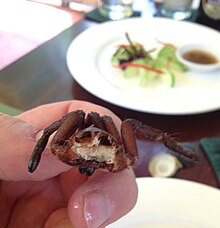Arachnophagy
Arachnophagy (/əˈræknɒfədʒi/, from Greek ἀράχνη aráchnē, 'spider', and φαγεῖν phagein, 'to eat') describes a feeding behaviour that includes arachnids. Aside from non-human creatures, the term can also refer to the practice of eating arachnids among humans.[1]
In non-humans

Arachnophagy is widespread among many animals, especially reptiles and birds. For example, arachnophagy is described among Philippine scops owls that feed on spider species such as Heteropoda venatoria.[2]
In humans
Like the human consumption of insects (entomophagy), arachnids as well as myriapods also have a history of traditional consumption, either as food or medicine. Arachnids include spiders, scorpions and mites (incl. ticks) that are consumed by humans worldwide.[3]
Fried spider, primarily tarantula species, is a regional snack in Cambodia. In Mexico, tarantula have been offered in tacos, with a splash of guacamole.[4] However, Mexican law forbids the sale of many species of tarantula for human consumption, and vendors offering this delicacy have been shut down by authorities.[5] In Venezuela, the Piaroa people have an history in eating the Goliath birdeater tarantula (Theraphosa blondi).[6]
Fried scorpion is traditionally eaten in Shandong, China.[7] Other countries include Vietnam and Thailand.[6]
Milbenkäse is a German speciality cheese that is exposed to cheese mites during ripening, and on consumption often still has mites attached to the rind.[8]
References
- ^ Christopher Healey, Margaret Florey (2003): Alune arachnophagy and approaches to spiders among an eastern Indonesian people. In: Journal of ethnobiology. Vol. 23, pp. 1–22.
- ^ 배리온-듀포, A. L. A. (2009) 오투스 메갈로티스 월든의 아라크노파기. 필리핀 곤충학자, 23(2), 174-178.
- ^ E.M. 코스타-네토, N.T. 그라보스키(2020년 11월 27일): 전 세계적으로 식용 거미류 및 무수한 식품 – 업데이트된 목록, 영양 프로필 및 식품 위생 관련 영향 In: Journal of Food and Feed: 0, 페이지 1-20. doi: https://doi.org/10.3920/JIFF2020.0046
- ^ "¡A comer tarántula! (no en Camboya, sino en México)". www.animalgourmet.com (in Spanish). Retrieved 2018-09-25.
- ^ "Aseguran tarántulas que serían convertidas en tacos Animal Político". www.animalpolitico.com (in Spanish). Retrieved 2018-09-25.
- ^ a b NBC 뉴스/베스 그린월드(2011년 10월 27일) : 믿지 못할 곤충 15마리를 먹을 수 있다.
- ^ Forney, Matthew (June 11, 2008). "Scorpions for Breakfast and Snails for Dinner". The New York Times.
- ^ "Würchwitzer Milbenkäse". Slow Food Deutschland e.V.





